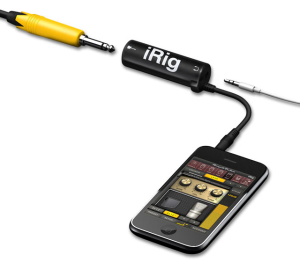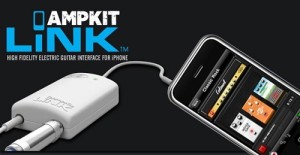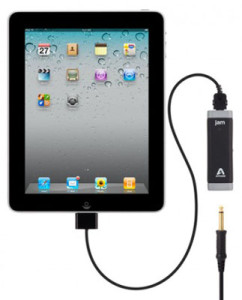The first time I heard about connecting your guitar to your iPhone was in March 2010 when PRS Released the Guitar Bud and an accompanying app called Jam Amp. The breakthrough wasn’t until IK Multimedia released the iRig and an iPhone version of Amplitube. About the same time Peavey and Agile released the AmpKit and the AmpKit link. Recently Apogee, makers of the acclaimed Apogee One and Apogee Duet for Mac, released their iPhone guitar interface – Apogee Jam. So which one to get? Since I own all of them (except the Guitar Bud) and have used them quite extensively – here’s my take:
iRig

The iRig is basically a splitter for the headset jack that provides a guitar input jack and a headphone output jack. It has no active components and just leads the input signal from the guitar to the mic.
Pros: The iRig is very reliable as it has no active components. It’s packaged into a nice design, yet sturdy, and takes very little space.
Cons: Since the input signal isn’t amplified, the iRig has issues with low input signal levels resulting in noise and crosstalk. It takes some tweaking to use it with a high-gain amp sim on the iPhone or iPad without getting feedback issues.
- Sound quality: 2
- Compatibility: 5
- Reliability: 5
- Overall: 3,50 (sound quality is weighted twice)
AmpKit Link
The AmpKit link is a battery powered device providing the same set of connectors the iRig does – an input jack for the guitar and a headphone jack.
Pros: It’s built-in amplifier makes the input level higher reducing the noise and feedback issues with the iRig.
Cons: The design of the AmpKit link is awful, it looks like a perfectly matched peripheral for a an early nineties PC. Build quality seems a bit weak, first one I got was DOA and the replacement only works properly if I don’t plug in the input cable the last few millimeters.
- Sound quality: 4
- Compatibility: 5
- Reliability: 2
- Overall: 3,75 (sound quality is weighted twice)
Apogee Jam
Unlike its two competitors above, the Apogee Jam is connected to the docking port at the bottom of the iPhone instead of the headset jack. Instead of delivering the analog signal to the app using the mic, it converts the audio into digital on-board.
Pros: The sound quality is amazing, the on-board digital conversion is completely noise free. I have the built-in noise filter in AmpKit off, which is impossible with the other two. It uses power from the phone via the docking port, so no batteries are needed. It has a led indicating clipping and a gain control on the device it self. A USB cable is included that makes it an audio interface for Mac (Windows not supported, unfortunately).
Cons: Apps need to be aware of audio devices plugged in to the docking port to work with the Apogee Jam. Apple’s own Garageband works fine, as does the AmpKit app (just plug in the cable first, and start the app after or restart it). Amplitube does NOT work with Apogee Jam. At €89 the Jam is also double the price of the two others.
- Sound quality: 5
- Compatibility: 3
- Reliability: 5
- Overall: 4,5 (sound quality is weighted twice)
Why do you need one?
When I first bought the iRig I didn’t know if I was going to use it or if it would be one of those gimicky things that end up in a box of stuff that seemed necessary when you first saw them. Turns out it’s one of the things I use most among my music gear. It’s been my main practice rig for quite a while, with the home studio, a.k.a. the bedroom, occupied by a sleeping toddler at all times when guitar practice is appropriate. Sound quality is good enough (especially now with the Jam) for practicing and making demo recordings, and since AmpKit records everything dry you can make recordings that you reamp later on your computer. I’d even consider bringing it along on rehearsals as a last resort if something in the regular setup breaks.
My recommendation is to go with an Apogee Jam and use it with the AmpKit app. The Jam is more expensive, but it’s so much better than the other two there’s no real competitition. Oh, and all of them work the same on iPhone and iPad.






